
This page contains brief reports on new products to be announced at the PMA show in Las Vegas, in mid-February, 2004. As in past years this is a highly subjective selection of those products which I regard as being of interest to both me and my readers. Just because a product is mentioned here doesn’t mean that it’s important, or even any good. Just because it’snotmentioned here doesn’t mean that it’s unimportant or no good. A listing on these pages simply means that it interests me, and I think it might interest you.
There are many web sites that list products in greater detail that I do here, and I have linked to them when appropriate. (DPReviewis a very good source for this material as isPhotographyBLOG). Product listings below are dated, with the most recent listings first. Coverage will continue though PMA (I will be attending for one day). Announcements of updates when they take place will be made onWhat’s New.
________________________________________________
February 16, 2004
Epson / Cosina
Possibly the strangest unannounced-but-displayed-under-glass product at PMA this year was an unnamed prototype of a Leica lens M-mount digital camera, completed with wind-lever (no, I’m not kidding). I must admit, that I walked right by the display case and didn’t notice this camera at all. It wasn’t till I read about it online that I did the proverbial double-take.
You can see some photographs and read what little more is known about it on theDP-NOWweb site. What’s interesting is that after last year telling the world officially that a Leica M digital camera was impossible, because of the shallow distance between the rear of the lenses and the film plane (err… sensor plane), Leica now says that advances in microlens technology on next-generation sensors now makes this possible, and that they are proceeding to produce such a camera. Who will be first with an interchangable lens M Series camera? Leica or Epson? Will the Leica version also have a wind-lever like the Cosina design? Fascinating stuff.
________________________________________________
February 14, 2004
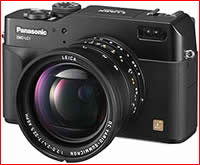
Panasonic
Unless you’ve been living under a rock you know that Leica’s recent digicams are in fact made byPanasonic. But, don’t scoff — it’s little known, but the CCD imaging chip in the first-generationCanon 1Dwas also from Panasonic’s parent companyMatsushita Electric. With that bit of historic trivia out of the way, Panasonic has introduced theDMC-LC1 Lumix. This is the same camera as Leica’s upcomingDigilux 2, except with an all black body and at a price several hundred dollars lower.
I think that the Panasonic’s all-black finish is more attractive as well as more discrete, but that’s just me. Regardless, at a price double that of other 5 Megapixel cameras itsF2.0 – 2.4 Leica DC Vario-Summicronlens as well as image quality are really going to have to deliver to make it succeed. At least theDigilux 2looks like a faux M Series Leica to partially justify its sky-high price. The camera is scheduled for delivery in March and will have a suggested retail price of $1,599. Ouch!
Kodak
Notwithstanding my early negative review of theKodak 14nlast year, Kodak has plugged away diligently at upgrading the camera’s firmware, and as previously reported here announced at PMA a revised version of the camera called theDCS Pro SLR/n.Imaging Resourcehas now published the most comprehensive report yet on the new camera’s improved features. If the improvements in image quality are as good as they appear, Kodak will finally have a very worthwhile DSLR for Nikon lens owners.
________________________________________________
February 13, 2004
For me, attending a trade show seems to raise more questions than it answers. And, while some reporters appear happy to simply summarize company press release, I’m often more curious about what wasn’t shown (or said) as I am about the products thatdidmake it to the show floor (albeit sometimes only as mock-ups behind glass cases),
Though the show is still going on for a couple of more days, I’m now heading home. But here are some observations, opinions and questions engendered by a full day of walking through the hundreds of booths at PMA 2004.
There were a few companiesMissingInAction at this year’s PMA. The most noticeable wasHasselblad. Simply not there, at arguably this year’s largest trade show, in the world’s largest photographic market. Yes, it is aPhotokinayear, but that’s still a long way off.
There, but clearly a casualty of the rapidly changing photographic scene, wasRollei. Their presence was almost embarrassing, stuck away as they were in a tiny unadorned booth at the very back of one of the halls, surrounded by companies that make photo buttons and studio background paper. How the mighty have fallen.
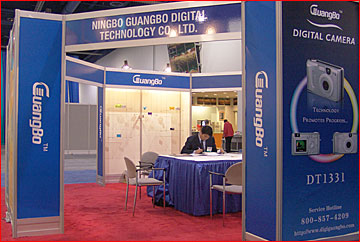
The show’s loneliest booth.
Could it be the exciting corporate and product name?
The 8 Megapixel Wars
Seemingly overnight a new battleground has opened up in the digital camera wars. First shipped just weeks ago, theSony F828was the initial runner out of the starting blocks. Though no others are shipping just yet, within weeks from now Sony will be joined on retailer’s shelves byNikon,Olympus,CanonandMinolta, each with its own 8 Megapixel wundercamera.
These cameras are what some are callingcross-overs. In addition to pixel counts that allow them to comfortably make A3 (11X17") prints without the need for ressing-up, they incorporate each manufacturer’s highest quality lenses, whether APO, ED, or L series glass. They have either 5X or 7X optical zoom ranges, wide initial focal length, and wide maximum apertures, typically in the f2 to f/2.8 range. These camera also incorporate just about every bell and whistle that each maker has thought up, and often far more than many users actually need.
They also are all priced at about U.S. $1,000, offering consumers remarkable value and photographic versatility for the money. They are not without non-monetary cost though. If the Sony F828 is any measure, these cameras will suffer from greater noise at anything other than the lowest ISO settings (64-100), and greater chromatic aberration will be seen than in cameras using chips with lower pixel counts but with larger photosites. Nevertheless, the 8MP market segment promises to be one of the most hotly contested during the next year or two.

So, which of these five cameras is best? It’s obviously not yet possible to say, though you can be sure that thebitswill be flying once samples of each of these contenders becomes available. But at the risk of making myself a human pinyata, I’m going to say that based strictly at this time on features, apparent functionality, and ergonomics, theMinolta Dimage A2appears to have a leg up on its competitors.
The stand-out features that appeal are…
Anti-Shake— the only 8MP camera so far with image stabilization
Manual zoom— electronic zooms as found on some cameras in this category seems to be at odds with thecross-overcamera ethos.
Usable RAW mode— and a large buffer that allows up to 3 three RAW files to be taken in rapid succession
Automatic viewfinder switching— shooting over 3,000 frames on three continents with my Sony F828 over the past 6 weeks has shown me that anything less can be a real hindrance to efficient shooting on a camera with both an EVF and a rear LCD.
So there you have it. My totally subjective initial observations, based on a very superficial look at each of the new contenders at a trade show. Will these advantages count when it comes to real-world shooting comparisons? Will another camera’s stand-out feature make it preferred? And of course, what about image quality? Stay tuned, because I hope to be able to answer many of these questions in the weeks ahead.
Finally, on this topic at least, why on earth am I spending so much time on these new cameras? When it comes to camera reviews theLuminous Landscapetypically concerns itself with high-end film cameras and DSLRs, not to mention the latest medium-format digital backs. What the hell is Reichmann doing reviewing digicams?
The answer is that my first and foremost interest is indoing photography— not in equipment per-se. But these new cross-over cameras are simply fun to use, offer tremendous shooting capability, and are great value for the money. They enable the photographer to use an (almost) pocket-sized camera to produce large prints of very high quality, and with a range of optical and other features previously only found on much larger and more expensive gear.
Is an 8MP cross-over camera a replacement for a DSLR? No, not for many photographers, but yes, possibly for some. Indeed I believe that these cameras are going to find many homes in the hands of people who already have high-end DSLRs, and who want something small and light-weight but that doesn’t cramp their creative capabilities or damage theirVisacard balance too badly. These are fun times. Let the games begin.

Chris BreezeandMichael Tapes
in a deep discussion about RAW conversion algorithms
________________________________________________
February 12, 2004

Just in case we weren’t sure where we were…
What appears below under today’s date are my impressions of the products that I found to be the most interesting at PMA. There may be some additional announcements over the next few days, but these are likely to be the primary ones.
I looked mightily for non-digital products of note, but really couldn’t find any. The digital steamroller has seemingly flattened everything in its path. Anecdotally, I overheard one industry insider tell another that due to reduced film sales a major U.S. camera store chain currently has 10,000 rolls of filma daygoing out of stock on its shelves nationwide. No wonder non-digital camera sales are tanked.

Phase One
I had an opportunity to visit withPhase Onetoday and to view and discuss their newP25all-in-one 22MP digital back, first reported on here last week. The design is stunning. Small, self contained and elegant. Assuming that the performance is the same as theirH25, this will be the definitive medium format digital back for professional photographers looking for an untethered medium fomat digital solution. Availability for Hasselblad V series, H1, Mamiya 645 and Contax 645 will begin in mid-late summer, depending on the camera model. Price will be U.S. $32,000.
Interestingly, Phase One had their product demonstrations at a professional photo studio here in Las Vegas, rather than at the show. Just the proper venue for the evaluation of such products. Kudos to Phase for doing things the right way.
Canon
Canonhad possibly the largest booth at the show. More like a carnival than a trade show booth. Of course they were showing their new1D Mark II,EF 28-300 f/3.5-5.6L ISand theEF 70-300mm f/4.5-5.6 DO IS. I will have field reviews of these three items as soon as samples are available for testing — which shouldn’t be too much longer.
Canon also had their new 8 MegapixelPowerShot Pro1on display. This was the first opportunity I had to hold one, and my initial impression was that though the camera is quite petite, it’s heftier than it looks. I was a bit dismayed though with the ultrasonic zoom. It doesn’t have the direct and instantaneous feel of a manual zoom ring, and it somehow places the Pro1 more in thedigicamthan thecrossovercamp, at last from a "feel" perspective. I look forward to having a review sample soon and doing a comprehensive comparison against the Sony 828 and the other gang of crossover 8MP cameras that are about to come to market.
Konica Minolta
Minoltashowed two new cameras of note — theDimage A2and theMaxxum 7 Digital. The A2 is very similar in appearance to the A1, but joins the new hot 8 Megapixel market segment. It is projected to have a street price of $1099, but a Minolta rep told me that he’d be surprised if it wasn’t under $999 when it hits the stores in a few weeks.
The Maxxum 7 Digital (displayed under glass) is based on the film body of the same name. It won’t be available until fall — again likely aPhotokinadelivery product, meaning late September. It is described as a 6MP camera, but I happened to overhear a Minolta rep talking to another, and he said that given the rate at which things were developing he wouldn’t be surprised if when it shipped it had an 8MP chip rather than a 6MP sensor. The rear LCD appears to be very large, and there are a great many control buttons on the rear panel, which seems to indicate a less "modal" design than some of its competitors. The Maxxum 7 Digital will take all current Minolta lenses. It also features Minolta’s Anti-Shake technology found in the A1 and now the A2 as well. This will work with all existing compatible lenses.
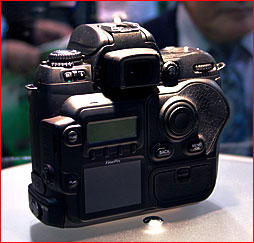
Fujifilm
TheFuji S3 Prowas on display under glass as well. It is still some months away from availability and looks like a Photokina product as well. It is a very chunky design, but has a much more refined finish than the S2 Pro. The only word on price was "More expensive than the S2 Pro".
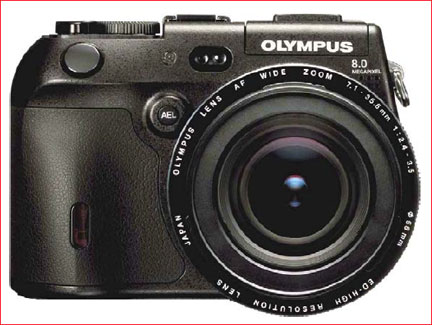
Olympus
Olympus announced today two products of significance. The first is theC-8080, their entry into the 8 Megapixel crossover digicam sweepstakes. This camera features a 5X 28-140mm f/2.4-3.5 equivalent zoom lens. It takes both xD and Compact Flash cards. U.S. "street" price will be $999, and shipment will start next month.DPReviewhas a preview online. The 8080 looks much nicer than any of that company’s other recent digicams. The body is very rounded and ergonomic and it is definitely intended to play off the marketing push that is being made by the E1.
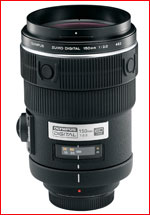
The second announcement of note is the Zuiko 150mm f/2.0 lens for theOlympus E-1Digital camera. This is equivalent to a 300mm lens in 35mm terms. No price has been given and delivery is mentioned as being in the Fall 2004 time frame.
If you’ve picked up any photography magazines in North America or Europe recently you’ll undoubtedly noticed the marketing blitz that Olympus is putting on for theirE1system. This was evident at the show as well, with Olympus having one of the larger booths for a second tier manufacturer. They are pulling out all the stops to position the E1 system as a major contender, in both the trade and consumer’s consciousness.
Leica
TheLeica Digilux 2was on display and I spent quite a bit of time examining it and chatting with Leica personnel. It is shamelessly styled along the lines of the M Series rangefinder cameras, and has some of thefeelof that body type. But, in the end from afit and finishpoint of view it isn’t in the same league. Having said that, it also isn’t anything to turn up ones nose at either.
Leica has tried to install as much of the M Seriesgestaltas they can, and in many ways it’s an appealing 5 Megapixel digicam. The lens, a28-90mm (equiv) f/2.0-f/2.4 Vario-Summicronpromises much, and the rear LCD is very large and bright. The viewfinder showed quite a bit of lag in the show’s low light level — more than other high-end digicams’ EVFs that I examined.
Some test shots made in RAW mode pointed out that SD cards, particularly small capacity ones, can be slow. I timed 8 seconds to write to a 64MB card., though Leica says that with larger faster cards this time drops to about 2 seconds. We’ll see, when one is available for testing.
I particularly liked the way exposure automation is handled. The traditional shutter speed dial has an "A"utomatic position, as does the lens’ traditional aperture ring. Turn it off A and you have shutter priority automation. Turn the aperture ring off the A position and you have aperture priority automation. Leave them both onAutomatic and you have — yup, full exposure automation. This is a design seen on the Rollei 6008 series of medium format cameras and one that I always thought to be very intuitive to use in the field.
Similarly there is an A position on the manual focus ring, and when turned to full manual focus a magnification window pops into the center of both the EVF or the very large rear LCD to aid focusing. The focus point is a fixed wide single point in the center of the frame — somewhat retro for 2004 I thought.
So too is the fact that for nearly $2,000 this is just a 5 Megapixel camera, while the rest of the industry is busy bringing out 8 Megapixel cameras with high-end lenses for nearly half the price. Whether the Leica’s image quality and cache can sustain it in the face of this competition remains to be seen. I hope so, because though Leica has recently said that they will be begin working on a real M series Leica that can use existing M lenses, it will likely be quite a while till that project reaches fruition. Like with the promised R Series camera digital back, we’ll just have to wait and see if Leica can survive the digital transition.
The Digilux 2 will be available in most markets within then next couple of weeks. I hope to have a review on this site soon.
Kyocera / Contax
Contaxhad nothing new to show other than some digital point and shoots. When visiting their booth though I was struck by the fact that half the booth faced away from the main traffic isle, and it was on that half that they had on display their medium format and 35mm cameras — almost as an embarrassed afterthought. The front of the booth was all digital point and shoots. What does this tell us about this company’s focus?
I was also dismayed at first by not being able to find them. It turns out that they were listed in the show directory under their corporate parent’s name,Kyocera Optics. A strange way to do things. I have a sense from what I saw at the show, and by comparison to some if its corporate peers, that this is a company losing direction and focus.
Kodak
Kodakhas upgraded itsDCS 14n, renaming it thePro SLR/n. This appears to be much the same camera design, but with an improved sensor, firmware and software. An upgrade program for existing 14n owners will be available. Now if they could only redesign my nose so that it doesn’t hit theMenubutton every time I lift the camera to my eye.
Foveon / Adobe
Following Monday’s announcement by Polaroid of the use of the Foveon X3 chip in a new digicam, Foveon announced today that Adobe will provide Foveon X3F RAW file support in Photoshop CS. Cameras supported include the Sigma XD9, XD10 and Polaroid x530. This support will become available from Adobe in the third quarter of 2004.
________________________________________________
February 11, 2004
Mamiya / Leaf
On my flight down to Las Vegas this morning I was browsing the latest issue of a photo magazine, which I had purchased at the airport. To my surprise I saw a full page ad for theLeaf*Mamiya*ProDigital 6, a package of theMamiya 645AFDwith 80mm f/2.8 lens and aLeaf Valeo 6digital back – all for a suggested list price of U.S. $6,999.
This is a very attractive package and price point for photographers, especially pros on a budget wanting to get into medium format digital. And since the Leaf back is of course removable, there is an open upgrade path to bigger imaging chips and larger files sizes when desired. I had heard through the grapevine that this was coming, but had not seen either a Leaf or Mamiya press release on the offering. Maybe I missed it. Or maybe this is some new form of stealth marketing – running magazine ads before announcing a new product.
In any event, this is likely to be just the tip of the iceberg in the reemergence of medium format’s dominance when it comes to image quality and shooting versatility for many pros. TheCanon 1Dschanged the equation in late 2002, but now a range of new portable MF solutions from various manufacturers are going to swing the pendulum back again. If you haven’t seen it yet, you may want to read my article onmedium format digitaland associated back reviews, published just a few months ago. There’ll be a lot more to come in the months ahead.
________________________________________________
February 10, 2004
Delkin
One of the greatest advances in camera to computer image transfer was theAska Cardbustransfer adaptor now sold outside of Japan byDelkin. Mac owners will be pleased to learn that they are no longer left out. An OS X beta driver isnow availablefor download from the Delkin web site.SDcard andMemorystickversions are alsonow available.
________________________________________________
February 9, 2004
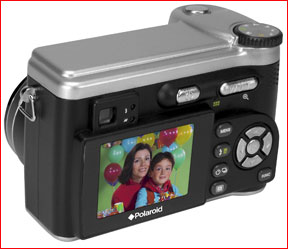
Polaroid / Foveon
Foveonhas finally broken out of its Sigma-only cocoon and has licensed its X3 chip to Polaroid. ThePolaroid x530is a 4.5 Megapixel digicam with a 3X optical zoom lens. It will become available in June and will have a SRP of U.S. $399.

Canon
Canon made the announcement of thePowershot Pro1official this morning. In addition to an 8 Megapixel sensor it has a Canon L-series f/2.4-3.5, 28-200mm equivalent USM zoom lens. RAW format is supported as as the Adobe RGB colour space. Interestingly, the chip in the Pro1 is a CCD, not a CMOS design.
As I mentioned yesterday, I believe that 8 Megapixel digicams are going to be thehot-spotof the photographic industry in the coming year. They offer photographers high quality images able to be printed up to A3 (11X14"), versatile focal length and aperture range, small size and convenience, and at around U.S. $1,000 for camera and integrated lens, a price point that most any serious photographer can afford. With at least one more major camera maker set to introduce an 8MP digicam this week, the plot thickens.
For the moment you can read more about thePro1atDPReview.Naturally you can expect my comprehensive hands-on field report and a comparison with theSony F828as soon as a production sample is available for testing.
Canon is also announcing today a new 35mm SLR film camera, theElan 7N/7NE. I guess film isn’t dead after all. Canon’s 9000 series printer line also has a new 8 ink wide-format model, thei9900. More on these as the week progresses.
________________________________________________
February 8, 2004
Canon
The German magazineColorFotohas apparently jumped the gun and published a report on a new 8 megapixelCanondigicam called thePowerShot Pro1. You can see pics and more info onPhotographyBLOG, as well as many of the web discussion forums, but I’d wait until later this week for the full andrealspecs. The 8MP digicam market is going to get very hot in the next few months. Crossover cameras like the Sony F828 , theCanon Pro1and others that are due shortly are going to charge the digital camera scene in a big way.
________________________________________________
February 5, 2004
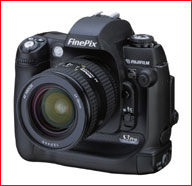
Fujifilm
Fujifilmhas announced today theS3 Pro, an evolution of theS2 Pro, based on their new dual pixel SR technology. These chips provide a second smaller pixel associated with each primary one that is used to increase the dynamic range. The S3 Pro is still a nominally 6 Megapixel camera. It also features a somewhat redesigned body. Availably and price are unavailable at the moment, but it could be summer until it hits the stores.
Regrettably Fuji is describing the S3 Pro as having "12 million recorded pixels" as a consequence of having these dual SR pixels. While technically true, it’s grossly misleading, and like the use of their hexagonal SuperCCD that lets them res a 6 MP file up to 12 Megapixels, this simply serves to confuse the hell out of uninformed potential buyers. The S2 Pro produces great images — as good or better than any of its competitors. The S3 Po is likely to be even better. Fuji really doesn’t need to play these marketing word games.
________________________________________________
January 30, 2004

Phase One
Phase Onemade it official today; beginning in May 2004 they will be shipping theP25, a completely self-contained 22 Megapixel medium format back. The back is reported to have a 4488 X 4,145 pixel sensor with an 8 stop dynamic range and 9X9 micron pixels. It will be available in Hasselblad H1, Hasselblad V series, Mamiya 645 and Contax 645 mounts.Additional information.
DXO Labs
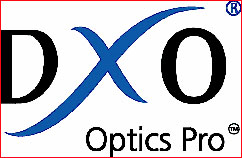
I reported two days ago onDXO Analyzer, a software / precision target-based test suite that performs highly rigorous and repeatable measurements of lens and sensor systems. This is a product designed for magazines, reviewers, and lens and camera manufacturers. Today,DO LabsintroducedDxO Optics Pro, a software program for photographers that runs on Windows and Macintosh computers. It is designed to eliminate Blur, Distortion, Chromatic Aberration And Vignetting.
Read thePress Releasefor more information, but even though it sounds too good to be true, I assure you that it isn’t. I have been working withDO Labs, have seen the software in action, and it appears that they can actually deliver on their promise. Naturally, a full review ofDxO Optics Prowill appear on this site as soon as possible.
________________________________________________
January 29, 2004
Phase One
Its been rumoured for some time, and the announcement still isn’t official, but by summerPhase Oneis going to be shipping the 22 MegapixelP25, a self-contained (untethered) full-frame 645 medium format back. A second model, theP20, with a smaller chip will also be available. The back features CF card capability (including FAT 32 support) and a Lithium Ion battery. A 2.2" colour LCD screen is incorporated. 48bit files are some 250MB in size, though RAW files are "only" 25MB on disk. The P20 and P25 will be available in Hasselblad H1, Mamiya 645 and Contax 645 mounts. GoodbyeKodak. HelloPhase One.
Canon
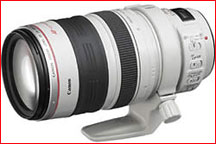
As people wake up and log-on in North America today they’ll discover what Europeans have known for some hours — Canon has officially announced theEOS 1D MKII— capable of 40 frame bursts at 8.5 fps in JPEG, or 20 frame bursts in RAW mode, all from an 8 Megapixel CMOS chipped camera. Amazing, and just what I could have used in Africa earlier this month 🙂
With a list price of $4,500, and a likely street price of under $4K once the feeding frenzy stops, this camera looks to be a winner. (I had previously criticized Canon in this space for using USB 1.1 rather than USB 2.0. It appears that the new USB port is simply used as a printer connection. I apologize for the misinformation).
DPReviewnow has a preview report online.
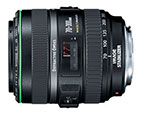
Canonhas also announced two new lenses; theEF 28-300 f/3.5-5.6L ISand theEF 70-300mm f/4.5-5.6 DO IS. The 70-300 is Canon’s second DO lens following the400mm f/4 DOof two years ago. Given its remarkable small size, if the optical performance is there this lens is going to appeal to a lot of photographers, regardless of price (which is bound to be high).
What’s interesting to note about these two lens’ introduction is that they are both relatively slow. Given the transition to digital, with its ability to produce high quality images at high ISO settings, it appears that lens makers have stepped away from the holy grail of the past half century (high speed) and are now settling for smaller size and lower weight at the expensive of large apertures. Understandable, but I’m not sure yet how I feel about it because of the negative impact on viewfinder brightness, especially with reduced frame cameras, and also on autofocus speed.
Readers can expect field review of these new products as they become available for testing, and also full optical tests of these new lenses using the just announcedDXO Analyzerwhich I will begin using in my reviews, starting immediately.
________________________________________________
January 28, 2004
Canon
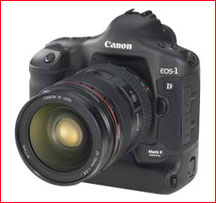
As expected Canon will be announcing their 1D replacement, the1D Mark IIat PMA. As of today the product has not beenofficiallyannounced but there have been wide-spread "leaks", so the product’s existence really isn’t confidential any longer. This is an 8 Megapixel version of the 1D, able to shoot at 8.5 FPS. It uses a CMOS chip with a 1.3X cropping factor. There are also a couple of new Canon lenses, but since these will all be officially announced shortly I’ll leave the specifics till that time.
I expect to be able to publish a hands-on field review of theMark II(as most people are calling it) in the near future.
Nikon
Nikon has officially announced theD70, its under $1,000 6MP DSLR, designed to compete with theCanon Digital Rebel. Based on the information made available it looks to be a very worthy contender, without many of the artificial limitations that Canon imposed on theRebel 300D.Indeed it appears that Nikon has now trumped Canon in build quality and features at this price point, at least for the time being.Letsgodigitalalso has a "First Look" at the D70.
Nikon also introduced theCoolpix 8700, an 8 Megapixel digicam aimed right at theSony F828. (Don’t be surprised to see several more such cameras in the days ahead). It appears to be based on theCoolpix 5700design, but hopefully will have many of that camera’s flaws corrected.
Breezebrowser
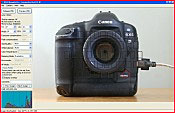
Chris Breezehas announced the availability ofDSLR Remote Pro, a program that allows photographers highly flexible and powerful remote control of their Canon DSLRs. This program is available now at an introductory price of $129, and is available for a 15 day free trial.
I expect to have a review ofDSLR Remote Proavailable shortly.
DXO Labs
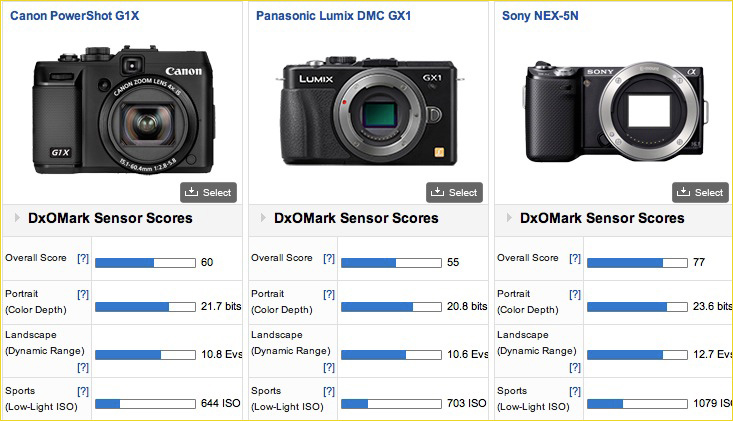
At nearly $20,000DXO Analyzeris not a product likely to be found in many homes soon. But, I anticipate that a great many camera and lens makers as well as review web sites and photography magazines will be adopting this product as their new testing standard. This is a software / precision target-based test suite that performs highly rigorous and repeatable measurements of lens and sensor systems.
I have been both an Alpha and Beta tester forDXO Labs, and have also been consulting with the company on this product. I will be publishing a comprehensive report on the design and implementation ofDXO Analyzerin the weeks ahead, and will also be using it to test new cameras and lenses from now on. In the meantime theirPress Releaseprovides an overview of this remarkable product’s capabilities.
________________________________________________
You May Also Enjoy...
Lockdown Landscapes
FacebookTweet In many ways, the pandemic has brought hardship and even tragedy to all our lives. For me, it also brought creative renewal. At the
Cloning Out The Can
One of the most common discussions in photographic circles over the past few years has been with regard to the veracity of photographic images. This

